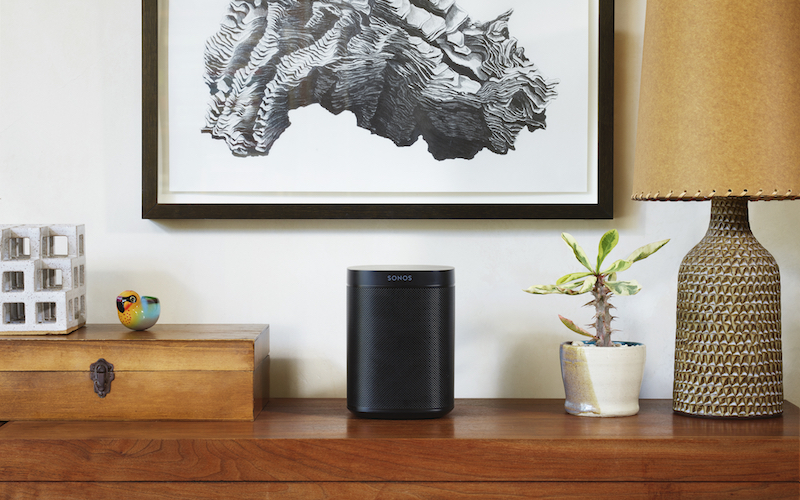Sonos has been a leader in wireless speaker technology for almost 15 years. Their wireless speakers are a standard for price, performance, design, and ease of use. The Sonos One, released in 2017, integrated Alexa voice control into a Sonos speaker and in 2019 Sonos added support for Google Assistant.
Amazon and Google have their own, well known lines of wireless, smart speakers with voice control, but there is one feature that separates the Sonos One from the competition: integration.
Both Amazon and Google smart speakers are great choices for a smart home if you don’t plan on using them for playing music. Don’t get me wrong, it isn’t that Amazon’s and Google’s offerings don’t provide quality sound. Every generation of their speakers have provided significant improvements in the sound quality they produce. Where these products fall down, compared to the Sonos One, is their lack of integration with third party smart home systems.
Yes, Amazon and Google smart speakers can be used as control points for other smart home products. But, unlike the Sonos One, other smart home products can’t control the music played on Amazon and Google smart speakers; and that tremendously constrains their value as a whole home music system.
Here are a few key ways a Sonos One can be integrated with other products in a smart home that highlight the failings of their Amazon and Google competitors:
- Integrating Sonos speakers with RoomMe personal location sensors gets as close as possible to the panacea of having your favorite music follow you from room to room as you walk around your home. RoomMe sensors are mounted on the ceiling of the rooms in your home. The sensors then track your location in the home; not by detecting you but by detecting your smart phone using Bluetooth.
Each occupant of the home can, through the RoomMe app on their smart phone, create “charms” that execute when that person enters, or exits, a room. For example, through RoomMe’s integration with Sonos speakers, a “charm” could be created that either plays a specific playlist, plays a specific TuneIn station, or simply starts the Sonos speaker playing the previously paused selection. When leaving a room, a “charm” can stop the music playing.
RoomMe “charms” can also include date and time criteria. So, a charm to start music playing wouldn’t run late at night when it could disturb people sleeping. Or, just for fun, a special playlist could be scheduled to play when a child walks out of their room on their birthday.
RoomMe even includes a sophisticated priority scheme to handle the situation when multiple people are together, in the same room.
- Crestron has provided some very easy to use integration modules for their proprietary, SimplWindows, programming tool that provides control of a Sonos system. I’ve created a basic example program showing how an alarm system could be integrated with a Sonos system to automatically pause all the Sonos speakers in a home when the homeowner arms the alarm system and leaves the home. Compare this to Amazon and Google smart speakers that require you to walk from room to room issuing a voice command to each smart speaker to stop playing. Not a lot of fun when you are running late for work and your family has left audio streaming around the house.
In addition, the Crestron program demonstrates how, when the homeowner returns and disarms the alarm system, the Sonos system can start playing their favorite music. This example program can be found on my GitHub here: https://github.com/jbasen/Crestron-Sonos-Example
Another way that Sonos speakers could be integrated with a Crestron system is to stop Sonos speakers in a room playing when an occupant leaves the room and presses the off button on a Crestron keypad at the door to turn out the lights.
- For those that don’t have a Crestron automation processor running their home, a SmartThings hub is a much more affordable option. After installing the SharpTools SmartThings SmartApp, you can easily create sophisticated if/then rules (no computer programming experience required) to control Sonos speakers in a home. For example, a rule could be created to stop all the Sonos speakers in a home when the GPS in your smartphones informs SmartThings that you, and your partner, have both left. Similarly, a rule could be created to play your favorite Sonos preset when you arrive home. A different preset could be played when your partner arrives home. SharpTools has both a free and premium plan. The free plan supports unlimited rules and will probably meet the needs of many users. One feature that may entice users to upgrade to the premium plan is the ability to send SMS messages based on triggers. So, if you are a working parent, you could receive an SMS message when your children arrive home from school; assuming they have smartphones that are integrated with SmartThings.
- IFTTT (If-This-Then-That) can be also used to create simple automation rules to control Sonos speakers. For example, an IFTTT applet can easily be created (no programming experience required) to pause all the Sonos speakers in a home when the phrase “Alexa, trigger goodnight” is spoken. Similarly, using the IFTTT location service you could pause all Sonos devices in your home when, using your cell phone’s GPS, the IFTTT location service detects that you have left your home.
All of the above functionality could be implemented using Amazon and Google smart speakers if they opened up their products to third party control. Unfortunately, each company’s vision appears to be to make their products the central controller of a smart home and only allow control of their speakers through voice commands. This limits their usefulness as a whole house music system in a smart home.
Unfortunately, even the Sonos One isn’t a perfect smart speaker. For example, if you issue a voice command to execute an Alexa routine, it will execute most commands but you will receive a verbal response that audio actions are not supported on this device. Some common routines that many people use are:
- Good Night – To set back your thermostat and turn off lights.
- Good Morning – To restore your thermostat to its normal set point, turn on lights if it is dark out, start your coffee maker, and play your news briefing on your Sonos speakers
- Good Bye – To set back your thermostat while nobody is home and turn off any lights left on in the house
- I’m Home – To restore your thermostat to its normal set point and turn on pathway lights if it is dark
These four routines will probably be executed every day. The goodbye and I’m home routines may be executed more than one time a day. Listening to the response that audio actions are not supported on this device, possibly 1500 times in a year, will become very annoying. The issue has been reported to Sonos so I’m hopeful it will be addressed in a future software update.
Additional limitations are that the Sonos One doesn’t currently support guard mode, Alexa messaging, drop-in or calling, and mixing Sonos Ones with Amazon speakers in music groups. While using your smart speaker as a speaker phone may be convenient for some people, almost everyone carries their cell phones with them these days so I don’t believe that is a significant detriment. However, if you are going to use Sonos One speakers as a whole house audio system, the lack of support for drop-in (which allows Alexa devices to be used as an intercom system) is a feature I believe many people would miss. While drop-in isn’t currently supported, the Sonos One does support making an announcement that will play on all the other Alexa enabled speakers in a home including Sonos One, Sonos Move, Sonos Beam, Amazon Echo, and more. At least a parent can make an announcement to inform the rest of the family that dinner is ready.
The lack of support for mixing Sonos One smart speakers with Amazon speakers in music groups requires a homeowner to be careful how they design their whole house audio system with these products. You simply can’t throw the speakers here and there in a home and create a cohesive audio system. For example, in a great room you might have three audio zones (living area, kitchen, and dining area). If you mixed Sonos One speakers and Amazon Alexa speakers in these three zones you couldn’t synchronize playback among all the speakers. As I said, it is just something you need to keep in mind when you plan your whole house audio system.
Similarly, there are limitations when Google Assistant is used as the voice service on the Sonos One. First, hands-free calling is currently not supported. In addition, voice match and purchasing are also not currently supported.
While the Sonos One is fairly priced at $199, not every room needs the audio quality that Sonos builds into their products. In, for example, a master bathroom or laundry room, where you might want to have a voice control point for your smart home and a speaker that is adequate for listening to the news or a podcast; the Sonos One is overkill. It would be great if Sonos released a smart speaker that competed with the Amazon Dot and Google Home Mini, and included the integration features of a Sonos speaker. A product that fit into the Sonos ecosystem, with reduced audio quality, and a more competitive price point, would be great for consumers that build their whole house audio system around the Sonos One and other Sonos speakers. For that matter, a Sonos One with a small, integrated, clock display would make a great bedside alarm clock.








